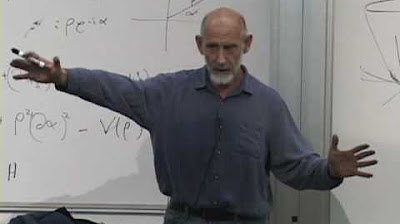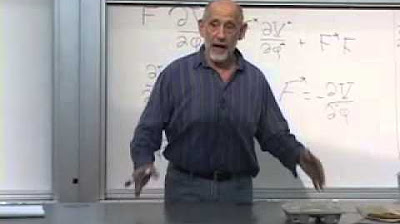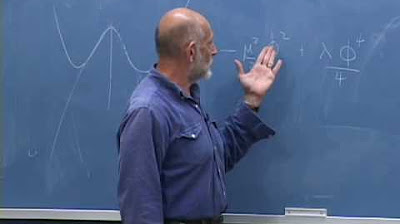Lecture 7 | New Revolutions in Particle Physics: Standard Model
TLDRThe video script delves into the concept of particle mass acquisition through spontaneous symmetry breaking and the Higgs phenomenon, focusing on the role of gauge invariance in particle physics. It explains how a particle like the photon can gain mass without violating gauge invariance, a fundamental principle in theoretical physics. The lecturer introduces the idea of spontaneous symmetry breaking using the example of a magnet system, contrasting it with explicit symmetry breaking caused by an external influence like a magnetic field. The script further explores the mathematical framework behind these concepts, including the Lagrangian for a complex scalar field and the significance of the U1 symmetry in the context of electromagnetism. It also touches on the Goldstone boson theory, which predicts massless particles arising from continuous symmetries. The Higgs mechanism is alluded to as a process that provides mass to gauge bosons like the Z boson, differentiating between the massless photon and other particles with mass. The summary emphasizes the importance of gauge invariance for a consistent quantum theory and the empirical evidence supporting it through the behavior of known particles.
Takeaways
- 📐 **Spontaneous Symmetry Breaking**: A particle like the photon can gain mass through a process called spontaneous symmetry breaking, which occurs without any explicit force acting on the system.
- 🧲 **Gauge Invariance**: Gauge invariance is a principle that allows the phase of a field to vary from place to place without changing the physics, which is fundamental in quantum field theory.
- ⚖️ **Conservation Laws**: The U(1) symmetry is associated with the conservation of electric charge, and gauge invariance is a key feature of electromagnetism and other fundamental forces.
- 🌀 **Goldstone Bosons**: When a continuous symmetry is spontaneously broken, massless particles known as Goldstone bosons emerge. These particles are associated with the cost-free variation of the field's phase.
- 🚫 **No Mass Term in Gauge Theory**: Adding a mass term to the gauge field directly violates gauge invariance, which is why the photon remains massless in such theories.
- 🔗 **Covariant Derivative**: The covariant derivative is introduced to maintain gauge invariance. It replaces the ordinary derivative with a term that includes the gauge field.
- 🤔 **Higgs Mechanism**: The Higgs mechanism is a process that gives mass to gauge bosons (like the W and Z bosons) by spontaneously breaking the gauge symmetry, which is a more complex extension of the Goldstone boson phenomenon.
- 🧵 **Vector Potential**: The vector potential is the field that, in the context of electromagnetism, gives rise to the electromagnetic field and is crucial for constructing a gauge-invariant Lagrangian.
- 🔄 **Electromagnetic Field Tensor**: The electromagnetic field tensor, composed of electric and magnetic fields, is gauge invariant, which means its dynamics can be consistently described in a gauge-invariant framework.
- 📉 **Potential Energy Shapes**: The shape of the potential energy function in a field theory determines the behavior of the field, including whether it exhibits spontaneous symmetry breaking.
- 🔗 **Field Dynamics**: The dynamics of a field are governed by its Lagrangian, which includes both kinetic and potential energy terms. The form of these terms is crucial for understanding the field's properties, such as mass and symmetry.
Q & A
What is spontaneous symmetry breaking?
-Spontaneous symmetry breaking is a phenomenon in physics where a system's ground state does not exhibit the full symmetry of the underlying laws governing it. This can lead to interesting physical consequences, such as the appearance of massless particles known as Goldstone bosons.
How does a particle like the photon gain mass through the Higgs mechanism?
-The Higgs mechanism is a process by which particles like the photon can acquire mass. It involves the interaction of particles with the Higgs field, a field that permeates all of space. When a particle interacts with this field, it can gain mass. The Higgs mechanism is a key part of the Standard Model of particle physics.
What is a domain wall and how is it related to spontaneous symmetry breaking?
-A domain wall is a boundary between regions of different orientations or configurations in a system with spontaneous symmetry breaking. It is a characteristic phenomenon associated with spontaneous symmetry breaking, where the system chooses one of the many possible symmetrical states, leading to distinct regions or 'domains' with different orientations.
What is the role of gauge invariance in the context of the electromagnetic field?
-Gauge invariance is a fundamental principle in the theory of electromagnetism. It ensures that the laws of physics remain unchanged under a gauge transformation, which is a local change in the phase of the electromagnetic potential. The requirement of gauge invariance leads to the introduction of the electromagnetic four-potential and the field tensor, which are essential for formulating the dynamics of the electromagnetic field.
Why can't the photon have a mass in a gauge-invariant theory?
-In a gauge-invariant theory, the photon cannot have a mass because adding a mass term to the Lagrangian for the electromagnetic field would break the gauge invariance. The photon's masslessness is a consequence of the local U(1) symmetry of the electromagnetic interaction, which is a fundamental aspect of the gauge theory.
What are Goldstone bosons and how are they related to continuous symmetries?
-Goldstone bosons are massless particles that arise in a quantum field theory when a continuous symmetry of the theory is spontaneously broken. They are associated with the degrees of freedom that correspond to the spontaneous breaking of the symmetry, allowing for a smooth variation in the field configuration without energy cost.
How does the Higgs phenomenon provide a mechanism for particles to have mass?
-The Higgs phenomenon provides a mechanism for particles to have mass through spontaneous symmetry breaking in the context of a gauge theory. When the symmetry is spontaneously broken, the gauge bosons can acquire mass without violating gauge invariance. This process is different from simply adding a mass term to the Lagrangian, which would break the gauge symmetry.
What is the significance of the U(1) symmetry in the context of the Higgs mechanism?
-The U(1) symmetry is significant in the context of the Higgs mechanism because it is the type of symmetry that, when spontaneously broken, can give rise to the Higgs phenomenon. In the case of the electroweak theory, the U(1) symmetry is associated with the conservation of electric charge, and its spontaneous breaking leads to the generation of masses for the W and Z bosons.
What is the role of the gauge field in maintaining gauge invariance?
-The gauge field plays a crucial role in maintaining gauge invariance. It transforms under a gauge transformation, which compensates for the transformation of the other fields in the theory. This ensures that the physical observables, such as the S-matrix elements in quantum mechanics, remain invariant under gauge transformations.
How does the concept of gauge invariance extend to local gauge invariance?
-Gauge invariance can be extended to local gauge invariance by allowing the gauge parameters to vary from point to point in spacetime. This local variation is compensated by the introduction of gauge fields, which transform under the gauge transformation. The requirement of local gauge invariance leads to the dynamics of these gauge fields, which can be described by a gauge-covariant Lagrangian.
What is the connection between gauge invariance and the mass of gauge bosons?
-Gauge invariance implies that gauge bosons, the force-carrying particles in a gauge theory, must be massless. This is because introducing a mass term for these bosons would break the gauge invariance. However, the Higgs mechanism allows for the spontaneous breaking of the gauge symmetry, which can give mass to the gauge bosons without violating gauge invariance.
Outlines
📚 Introduction to Particle Mass and Symmetry Breaking
The paragraph introduces the concept of how particles like photons can gain mass through a process known as spontaneous symmetry breaking, specifically via the Higgs phenomenon. It emphasizes the importance of two technical concepts: spontaneous symmetry breaking and gauge invariance. The discussion also includes an example of spontaneous symmetry breaking using a simple model of magnets, where individual magnets can point up or down, and the energy is lower when they are parallel. The text explains how the symmetry is spontaneously broken when all the magnets align in one direction due to energy considerations, and contrasts this with explicit symmetry breaking, which occurs when an external influence like a magnetic field dictates a preferred direction.
🧲 Magnetic Moments and Symmetry Breaking in Particles
This paragraph explores the question of whether a particle with no charge but with spin can have a preferred orientation in a magnetic field. It discusses the concept of magnetic moments, using the neutron as an example. The text then delves into the propagation of spin changes and the concept of waves of reorientation. It also explains how to differentiate between spontaneous and explicit symmetry breaking in a magnetic system, highlighting the role of domain walls in the case of spontaneous symmetry breaking.
🚀 Field Theory and the Dynamics of Symmetry Breaking
The paragraph presents a field theory example involving a real-valued field that can take on any real value. It discusses the dynamics of this field, controlled by a Lagrangian, which includes a term for kinetic energy and a potential energy term. The text explains how the potential energy can be symmetric with respect to changing the field's value, and how the field can have two states of lowest energy, representing spontaneous symmetry breaking. The discussion also touches on the concept of domain walls in this context and how they signify the breakdown of symmetry.
🌌 The Cost of Energy and Symmetry Breaking in Fields
This section discusses the energy implications of a field transitioning between different states. It explains that a sudden change in the field state is energetically costly due to the derivative energies involved. The text then explores the conditions under which a field might prefer to remain in a state of spontaneous symmetry breaking, as opposed to a situation where the potential energy landscape does not favor any particular state, indicating unbroken symmetry. The concept of an instability in the system, where a small perturbation can significantly change the system's state, is also introduced.
🔥 High Temperature Fluctuations and Symmetry Breaking
The paragraph examines the behavior of a system at high temperatures, where random fluctuations could result in equal amounts of 'up' and 'down' states, on average. As the system cools, it undergoes a process where patches of aligned states form and connect, eventually leading to a state determined by random chance. This process is described as spontaneous symmetry breaking, and the paragraph distinguishes between discrete and continuous symmetries, with examples provided for each.
🌀 Continuous Symmetry and Goldstone Bosons
The text delves into the concept of continuous symmetry, where configurations can be interpolated continuously from one to another. It discusses the idea of Goldstone's theorem, which predicts the existence of massless particles, known as Goldstone bosons, when a continuous symmetry is spontaneously broken. The paragraph provides examples from field theory and condensed matter physics, such as ferromagnets and spin waves, to illustrate the concept of Goldstone bosons.
🤔 Gauge Invariance and the Higgs Phenomenon
The final paragraph introduces the concept of gauge invariance, which is a type of local symmetry transformation that can vary from point to point in space. It discusses the implications of gauge invariance for the Lagrangian of a system and how introducing a gauge field can make the Lagrangian invariant under such transformations. The text touches on the idea that gauge bosons, like the photon, cannot have mass if gauge invariance is to be maintained, which leads to the Higgs phenomenon as a mechanism to give mass to particles like the Z boson.
Mindmap
Keywords
💡Spontaneous Symmetry Breaking
💡Higgs Phenomenon
💡Gauge Invariance
💡Goldstone Bosons
💡Vector Potential
💡Covariant Derivative
💡Electromagnetic Field Tensor
💡U1 Symmetry
💡Lagrangian
💡Massless Particles
💡Quantum Field Theory
Highlights
Explaining how a particle like the photon can gain mass through spontaneous symmetry breaking and the Higgs phenomenon.
Introducing two key concepts: spontaneous symmetry breaking and gauge invariance, both essential for understanding particle physics.
Using a simple model of magnets to illustrate spontaneous symmetry breaking and the energetic preference for parallel alignment.
Discussing the ground state of a magnet and how the orientation of spins is determined by a single spin far away, indicating a spontaneously broken symmetry.
Differentiating between spontaneous symmetry breaking and explicit symmetry breaking with the example of a magnetic field influencing spin orientation.
Exploring the existence of domain walls as a characteristic phenomenon of spontaneous symmetry breaking in magnetic systems.
Describing the mathematical representation of a field theory with a real-valued field and its dynamics controlled by a Lagrangian.
Presenting a complex field theory example with a U1 symmetry and how it maintains this symmetry under phase rotations.
Discussing the concept of Goldstone bosons and their association with spontaneously broken symmetries in field theory.
Explaining that gauge invariance is a fundamental principle in theoretical physics, essential for a consistent mathematical structure.
Introducing the idea of gauge fields, such as the electromagnetic field, and their role in maintaining gauge invariance.
Demonstrating that the electromagnetic field tensor is gauge invariant, allowing for a consistent dynamics of the field.
Highlighting that gauge invariance forbids mass terms for gauge bosons like the photon, maintaining their massless nature.
Exploring the Higgs phenomenon as a method to give mass to gauge bosons without violating gauge invariance.
Discussing the theoretical implications of spontaneous symmetry breaking on the mass of particles and the removal of Goldstone bosons.
Providing a comprehensive overview of the mathematical framework underlying gauge theories and their importance in particle physics.
Transcripts
Browse More Related Video

Lecture 8 | New Revolutions in Particle Physics: Standard Model

Lecture 9 | New Revolutions in Particle Physics: Standard Model

Electroweak Theory and the Origin of the Fundamental Forces

Supersymmetry & Grand Unification: Lecture 9

Lecture 10 | New Revolutions in Particle Physics: Standard Model

Lecture 6 | New Revolutions in Particle Physics: Standard Model
5.0 / 5 (0 votes)
Thanks for rating: